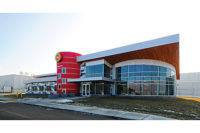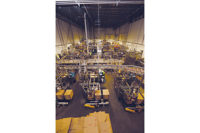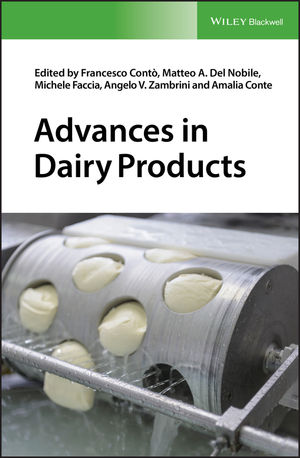Agropur USA invests in ESL products
The U.S. division of the Canadian cooperative is a major contract manufacturer of ultra-high temperature pasteurized dairy and nondairy beverages. The Minnesota-based dairy is growing its own brand, too.

Natrel is Agropur’s brand for asepticallly packaged fluid milk. It uses the Schroeder brand for fresh milk.

Eric Brunelle, the president of the U.S. fluid milk division of the Canadian dairy cooperative Agropur, said the co-op’s goal is to be among the top 10 of the world’s most important dairies. Photos by Nate Larson

VP of Sales Eric Gafkjen

Director of Marketing Eric Jacobson

VP of Finance David Ellis.

Agropur processes HT/ST milk in addition to extended-shelf-life beverages. Bottles of 1% Schroeder milk (right) move to the casing room.
The dairy industry thrives on tradition. Independent dairies have built long-term relationships with consumers that are passed from generation to generation. Family-owned regional dairies rely on these loyalties.
Take Grade A whipping cream, for example. Grandmothers (as well as the professional foodservice community) in Minnesota’s Twin Cities have long favored the vat-pasteurized cream from Schroeder Milk for its whipping and holding characteristics. The cream is so well-known that people refer to by its packaging: “the cream in the purple carton.”
But tradition alone can’t sustain processors, especially the ever-dwindling community of family-owned dairies. Any food and beverage manufacturer needs to develop new products, invest in new processing technologies, seek new markets, nurture new customers and find new partners. And that is exactly what happened with Schroeder, which was purchased in 2008 by Agropur Inc., a subsidiary of the Agropur Dairy Cooperative, the Canadian dairy cooperative.
Now known as Agropur Division Natrel USA, the fluid milk subsidiary is based in St. Paul, Minn. Agropur also has a U.S.-based cheese and ingredient division. (See related article on page 56.) These milk and cheese businesses are key components of Agropur’s long-term growth strategy. Though large in geography, Canada is small in population; it’s about 10% of the size of the United States. So to grow the company, management is looking outside of Canada.
In the fiscal year ended Nov. 2, 2013, Agropur’s revenues rose 5.2% to Cdn$3.8 billion, or roughly US$3.4 billion. Sales outside of Canada were 28.6% of the total (they were 27.2% in 2012). Besides the U.S. operations, Agropur had a subsidiary in Argentina, which it has since sold.
Branding, manufacturing
In December 2013, Eric Brunelle, a veteran finance executive from Agropur’s head office, was tapped to run the USA Natrel division as president, succeeding Bob Kirchoff, the long-time head of Schroeder Milk.
Brunelle already has found differences in the shopping habits of the two countries. For example, Canada is a market of mostly branded milk and private label does not exist in any meaningful way, he said. The reverse is true in the United States.
In addition to packaging its own milk brands, the dairy has a thriving contract manufacturing business, processing conventional and organic milk, nutrition shakes and plant-based beverages (see related article on page 60). Schroeder is the division’s brand of fresh milk. Compared to its regional rivals, Schroeder is a niche brand, said Director of Marketing Eric Jacobson. Although it is not the dominant milk brand in the Twin Cities, the dairy sells a lot of milk and cream to retail, school and foodservice customers.
Natrel is also the brand name of the dairy’s aseptically packaged milk. The processor is taking this brand to markets beyond the Midwest; it does particularly well in New England, Jacobson said.
Brunelle said he wants to use the cooperative’s research and development center in Canada to help develop products for the United States. In the last year the Canadian division expanded its Natrel line with Baboo Step 1, a milk product for children ages 12 to 24 months, and Baboo DHA Step 2 for toddlers age 2 years and older. The Canadian cooperative also introduced Natrel Maple flavored milk and added a new hazelnut flavor in its Café line of coffee creamers.
That’s not to say the U.S. division has not been innovating. At Expo West in Anaheim, Calif., in March, the company introduced a new line of milk and coffee beverages in mocha and vanilla flavors, and a line of flavored milk targeted to adults in chocolate ganache and sea salt-and-caramel flavors. In 2011, it rolled out flavored milks called Dynamoo as a sub-brand of Natrel.
Changing tastes
Jacobson has been looking at trends in the industry, especially where consumers buy milk and how they drink it. The grocery store is no longer the only game in town. Club stores, convenience stores and drug stores today compete for consumers’ food dollars. The dairy is in all of these channels.
As the Milk Processor Education Program points out, most milk is consumed at breakfast. But sales of milk in gallon jugs are falling as consumers eat less breakfast cereal and as they eat breakfast away from home. Dairy marketers, including Jacobson, have noted the rising popularity of milk-and-coffee beverages and milk and fruit juice combinations. Coffee chains are big users of fresh milk and the USA Natrel division counts Minneapolis-based Caribou Coffee Co. as a customer.
To develop new ideas in dairy, Jacobson analyzes the so-called “need-states” of consumers, examining the reasons why they choose a specific beverage. Consumers might be looking for energy, a snack or a dessert, he said.
“There are still growth opportunities in milk,” Jacobson said, rattling off options like single-serve packages and value-added milks (including lactose-free varieties and protein-fortified beverages).
Shelf-stable milk
When Natrel launched Dynamoo, it enlisted the help of the Midwest Dairy Association, St. Paul. Besides assisting in the package design, the association helped Natrel navigate school meal regulations while it was developing the product, said Midwest Dairy Association VP of Business Development Cindy Sorensen.
The association also helped Natrel with communication messages directed at school nutrition directors and helped to promote Dynamoo as an after-workout refuel beverage. At a convention for school athletic directors, the dairy and the association shared a booth and handed out samples.
Sampling of Natrel products at other venues also has proven to be successful, Jacobson said. The company gives away samples of Dynamoo at home and garden shows, running events and hockey games. The company also raised awareness of Dynamoo by sponsoring a Zamboni ice-cleaning machine at an area skating rink and hockey center.
While the market for shelf-stable milk is growing, there is low awareness of what aseptic milk is, Jacobson said. Consumers need to be educated that it is heat treatment and packaging (not the addition of preservatives) that keeps aseptic milk fresh.
Educating consumers on usage occasions also is key. Shelf-stable milk can be used for drinking and cooking, just like traditional milk. It also allows consumers to have milk in many other situations as well, including emergency milk during storms, back-up milk for when one runs out of milk at home, lunch boxes, car trips, field trips and camping, Jacobson added.
Club stores, which merchandise multipacks of the milk on pallets, have helped educate the public about UHT milk, VP of Sales Eric Gafkjen said. And shelf-stable milk is better known in communities with a large influx of consumers from Latin America, where aseptic milk is more the norm, Gafkjen added. He also said that once mainstream consumers understand the carbon footprint of aseptic packaging compared to other packages, they will be more accepting of it.
Contract manufacturing
In 2013, the Natrel division USA’s sales increased 6%, thanks to several new manufacturing agreements, according to the company’s annual report. Aseptic and ESL products are attractive because they deliver higher margins compared to fresh milk products. Producing them, however, requires a bigger infrastructure, Brunelle noted.
Making value-added beverages will be the growth engine for the company, Gafkjen said. The longer shelf life of aseptic products allows a processor to ship them further from the plant. The dairy trucks its Natrel Dynamoo brand to the Northeast and Southeast. Co-packed product goes to Asia and Europe. Fresh milk could not travel that far.
While the company also processes plant-based beverages like coffee-flavored soy drinks, management is committed to milk. “Milk is the foundation of our company, so we won’t be abandoning dairy,” Jacobson said.
In order to keep up with the demand for aseptically packaged products and to secure new business, Agropur needed to add more capacity. So this spring the dairy is installing a third aseptic filler in the St. Paul plant.
The dairy has built a strong co-packing business in extended shelf life and aseptic products by being a good processor and being responsive to customers. For example, look at the dairy’s organic milk business. VP of Operations Jim Schultz noted that each customer has its own requirements for receiving, testing, co-mingling and processing organic milk. While challenging, the dairy has been able to successfully manage the different milk sources and find room in the silos to store the milk.
It would not be an overstatement to say that Schroeder launched Organic Valley into the fluid milk category. Schroeder Milk was the first dairy to package fluid milk for the co-op, recalled Organic Valley Chief Operating Officer Louise Hemstead. The La Farge, Wis.-based cooperative owes “a debt of gratitude” to Schroeder, because Schroeder was the only dairy “willing to take us,” she said. The 12,000 gallons of organic milk trucked each week to the plant went through the line in about 45 minutes, she said.
The fact that Schroeder helped a start-up business does not surprise Gafkjen. That willingness to take on small accounts exists today.
“I could name 10 others like that,” Gafkjen said. “We are willing to take the shot on up and comers” and help them grow, he said, adding that the dairy has lower minimum quantity requirements than some other processors.
Organic Valley’s relationship with Schroeder, and now with Natrel USA, has grown. The dairy is “a cornerstone in the Midwest for the processing of packaged milk,” Hemstead said.
Brands come to the dairy because of its reputation for quality manufacturing, said VP of Finance David Ellis. Through automation and information systems, the company has also become more efficient as a manufacturer.
“We understand this segment of manufacturing and have long-term relationships with our customers. The company will grow by renewing and extending contracts, and acquiring new customers, as well as by expanding capacity and product innovation,” he said.
The way to grow
Entering the U.S. market required some big investments for the Canadian cooperative. In 2008 it acquired Schroeder Milk and the following year purchased Farmland Dairies in Grand Rapids, Mich.
Natrel Division USA President Brunelle is a chartered accountant, the Canadian equivalent of a certified public accountant in the United States. He joined Agropur in 1992 as an internal auditor and worked his way up to vice president of finance.
Ever the accountant, Brunelle looks for ways to remove costs in manufacturing. Automated casing equipment and robotic palletizers are two examples that cut cost and improve worker safety. But he’s not afraid of spending money, either. The plant in Grand Rapids is being upgraded, refurbished and expanded, he said.
Like every other president of a dairy company, Brunelle has to come to grips with decreasing sales of fluid milk in the United States.
“HTST milk has been in decline 1% or 2% a year,” he noted.
Asia (particularly China), on the other hand, represents a huge market for aseptic milk. A report by the U.S. Dairy Export Council shows that China imported 79,733 tons of UHT milk in 2012, and 2,695 tons were from the United States. In 2010, China imported 8,668 tons (34 tons from the United States). Clearly, there is more potential business in China than any one dairy currently can serve.
Co-packing ESL beverages is going to help Agropur grow (as will the cheese and dairy ingredients business). The cooperative’s goal is to be in the top 10 of the world’s most important dairies, Brunelle said. With annual revenues of $3.4 billion in 2013, Agropur needs to more than double its revenues. According to Rabobank’s latest ranking of the world’s largest dairies, the revenues of the 10th firm were $7.7 billion.
Despite the challenge of sales and cost controls, the U.S. fluid milk operation has another valuable asset beyond equipment: employees. This veteran and hard-working force has the technical skills to manufacture quality products and they deliver good customer service, Brunelle said. For the company to expand its own brands and acquire new contract manufacturing business, it will rely on the employees to make it happen.
Agropur makes cheese and ingredients, too
More than 28% of Agropur’s annual revenues come from outside Canada. In addition to its fluid milk subsidiary based in Minnesota, Agropur has a separate cheese and ingredients (CID) business based in Wisconsin. The parent company is investing in the infrastructure of the cheese plants and investing in acquisitions.
Doug Simon is President of Agropur’s USA Cheese Business Unit. The U.S. operations include four cheese plants (in Luxemburg, Little Chute and Weyauwega, Wis.; and Hull, Iowa).
Reneck Cayen, VP of Sales for the Ingredients Business Unit, oversees the marketing of all Agropur CID ingredients including: products out of the Agropur cheese plants, an ingredient and contract manufacturing plant (La Crosse, Wis.) and a drying blending plant (Preston, Minn.).
The U.S. cheese plants manufacture Cheddar, Colby, feta, mozzarella, mozzarella sticks, Provolone and curds. These cheeses consistently win awards in the industry’s major contests, including World Championship Cheese Contest (receiving the World Champion Sharp Cheddar award in 2012) and the U.S. Championship Cheese Contest. In the latter contest in 2013, Agropur came away with Overall Second Runner Up for Medium Cheddar, U.S. Champion Mild Cheddar, U.S. Champion Medium Cheddar, U.S. Champion Whole Milk Mozzarella and U.S. Champion Feta 2013.
In 2013, Agropur purchased Foremost Farms USA’s dry blending business. In a statement last year, Agropur CEO Robert Coallier called the ingredients business “an important sector for the future growth of our organization in the U.S., and this investment, which is in keeping with Agropur’s strategies, will allow us to grow in the baking and blending industry.”
Between their dairy-derived manufactured and custom blended products, the ingredients division produces powders (skim milk, whole milk), whey, whey protein concentrate, whey protein isolate, whey permeate, functional proteins, stabilizer systems, anti-caking agents, bakery blends, lactose and reduced lactose whey. The products are marketed under the brand names Crino Premium Dairy Ingredients, IsoChill Value-Added Dairy Ingredients, Keystone Stabilizers, Cornerstone Proteins, DariGen Specialty Powders, Capstone Anti-Caking Agents, BakiGen Bakery Ingredients, PZ-44 and Reddi-Sponge.
Looking for a reprint of this article?
From high-res PDFs to custom plaques, order your copy today!









